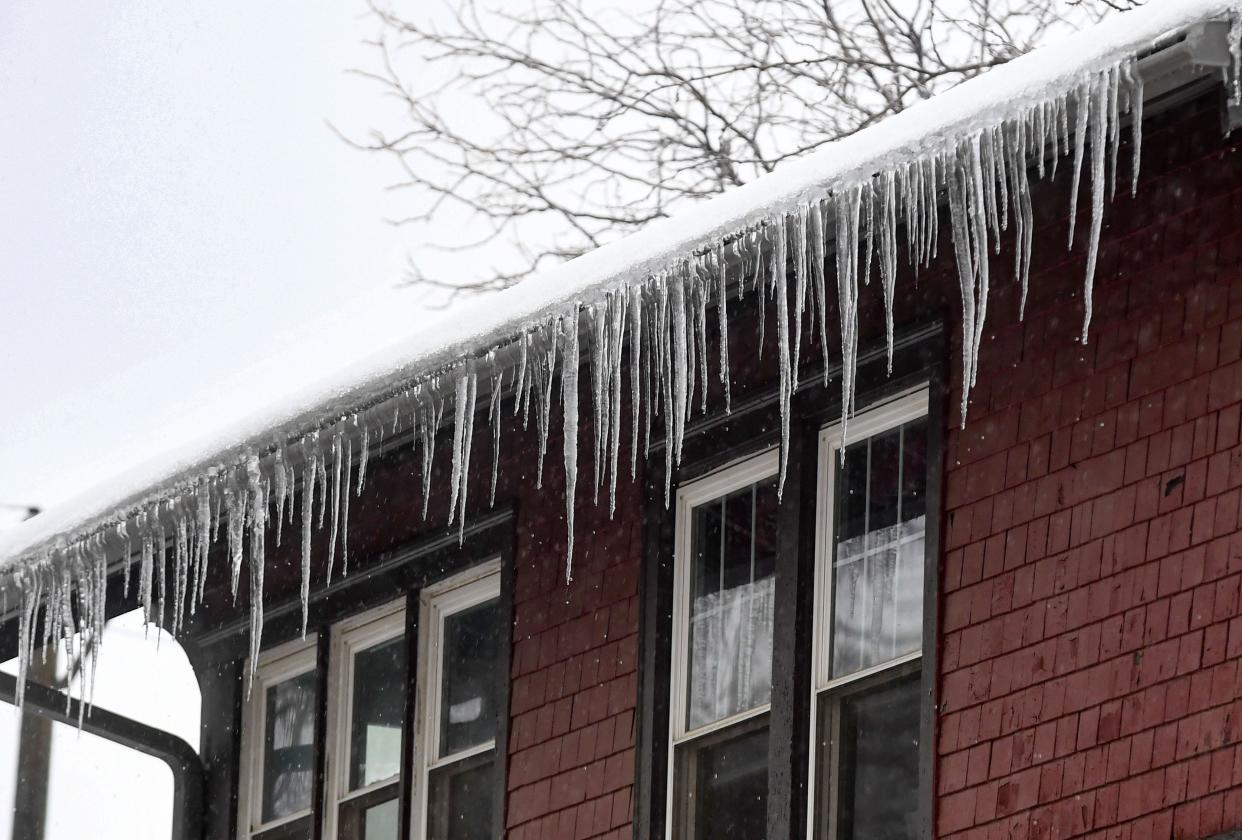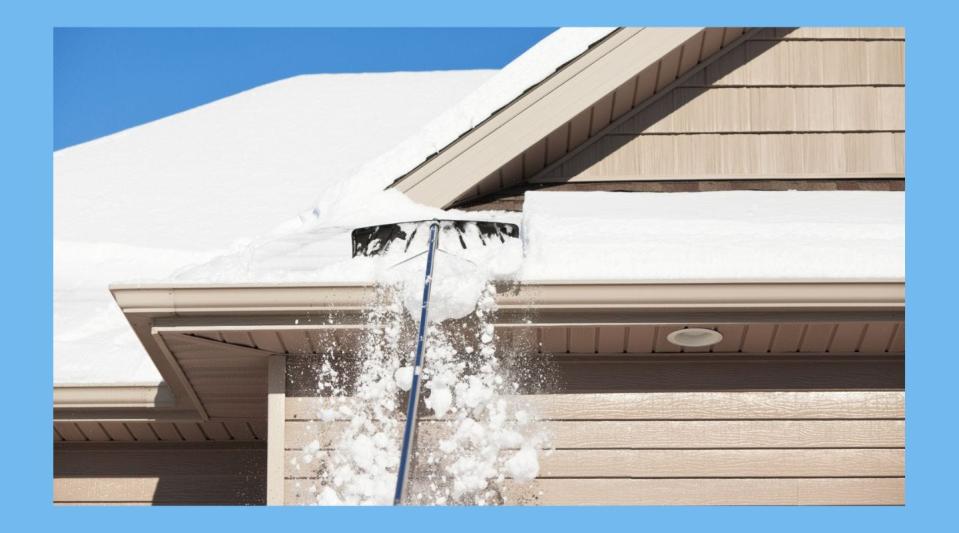Winter can bring issues for homeowners. Here's how to protect the roof over your head.

Already, the winter season in Sioux Falls is on pace to break some snowfall totals, but the precipitation can create issues for homeowners beyond digging out driveways and sidewalks.
From Oct. 1, 2022 to Jan. 3, the city saw more than 34 inches of snowfall, making that winter stretch the third snowiest of all time. That's behind the 36.4 inches that fell between 2015 and 2016 and the 43.7 inches that fell between 1968 and 1969 within that timeframe.
On Thursday, the National Weather Service reported the snow depth reached 19 inches. This was the first time in 13 years the city saw 15 or more inches on the ground. Sioux Falls' deepest snow depth came in 2004 and was measured at 22 inches.
For homeowners, snow can cause roofing problems. After talking to a couple roofing companies, here are some tips they provided.
Ice dams a common issue, steamers a recommended remedy

One of the most common issues homeowners face is ice dams. They can cause severe issues like tearing off gutters and loosening shingles.
“What happens is that water expands when it freezes,” Kelly Swee, co-owner of Premier Systems Roofing, told Argus Leader. “It’s got to go somewhere. It can’t get off the roof, so it starts going back up the roof and goes underneath your shingles, and when it starts melting, that’s when they start getting water in their house again.”
There are some signs to look for if you suspect an ice dam, Swee added. Those include icicles hanging off gutters around the fascia, ice on sidewalls or siding. Ice dams occur when heavy snow buildup melts during the day and then refreezes when temperatures drop overnight, according to the National Weather Service. Heavy snow can also be a catalyst of creating an ice dam.
According to Swee, one of the ways to fix the issue is by hiring companies who specialize in ice dam repair. However, some companies do it differently. Some use a high-pressure washer with hot water; Swee warned that this might not be the best way to remove the icicles and can cause further damage to your roof.
“What it does is it strips all that off, but what you’re doing is taking all the granules off the shingles, you’re damaging it with a pressure washer,” Swee said.
Instead, he recommends companies that use a low pressure steamer, as the equipment is less likely to damage or burn the adjacent shingles.
Preventative measures today can keep you off the roof tomorrow
Mark James, owner of James Roofing and Construction, told Argus Leader heating tape is another measure to prevent issues with heavy snowfall and ice buildup. James recommended running a heat line along the first two or three feet on the roof line.
"A lot of times, it's good to run that stuff through the gutter and just leave a cord by your front door," James said. Just plug that stuff in and unplug it when you don't need it."
However, ignoring the issue or letting too much ice buildup can destroy the edge of roofs, causing water and ice to run within walls and ruin windows, James added.
While homeowners could try to fix the problem on their own, being on a roof without proper gear during the winter can become dangerous quickly. And, if a homeowner is able to get on their roof, hacking away at the ice dams with a hammer or other object can be harmful to the shingles. It's also not recommended to use shoe spikes while on roofing, as they can cause damage to shingles.
“You just have to ride it out. Once it melts, you’re going to have interior damage because of it,” Swee said. “I’m not saying all ice dams will come into your home, but it’s a very good, high percentage that it’s going to leak inside your house. You’re going to get some water stains coming up on your ceilings, but I can’t say that every house in Sioux Falls has to do this, but it's a possibility. It happens.”
Premier Systems doesn't do steam work but instead refer people to Absolutely Clean Window Washing.
Clean your roof
With nearly three feet of snow already fallen in Sioux Falls, some within the industry are urging homeowners to clear their roofs. There's a number of ways to get snow off of a roof, including roof rakes, which are commonly sold at stores throughout Sioux Falls. Rakes are typically about 14 to 24 feet long.
"I would honestly say probably the best thing to do right now is get a snow rake and probably remove at least three feet to prevent ice damming," James said.
Outside of roof rakes, salt pucks can also be used, but those can cause negative effects like killing your lawn in the spring due to salt.
"You could do that to help minimize and get some of the weight, and it will prevent an ice dam from forming again," Swee said.
While Swee said it's "highly unlikely" a roof would collapse due to heavy snow, it can happen. On Dec. 12, 2010, the roof of the Metrodome, a stadium in Minneapolis that hosted the Minnesota Twins and Minnesota Vikings, collapsed after a system dumped more than 17 inches of snow. That roof was made of fiberglass fabric.
"You do see it from time to time, especially on an old house," Swee said. "It's important to get the snow off [when] it's starting to pile up that high."
Humidifiers, bathroom fans can lead to water spots
On cold days, when temperatures drop to around 15 to 20 degrees Fahrenheit, humidifiers can have detrimental effects, Swee said. With snow and cold weather, it's possible to create openings for moisture to enter, leading to water spots on the ceiling.
“What happens is that humidity has to go somewhere," Swee said. "That air is going to go up into that attic, the air could escape in the attic which is going to cause it to freeze or frost over in the attic roof."
In the winter, air can become dry, leading to dryness and flaking skin. While it seems like a good idea to have the humidifier on during winter, Swee said that can lead to bigger problems – especially with roofing. While Swee recommends against using a humidifier, the roofing contractor said it can still be on but no higher than 10%.
Bathroom fans can also add to that challenge, which can sometimes be left on for a long period of time.
"If that (vent) doesn't have it's own pipe penetration coming out of the roof … Then you're shutting hot air into your attic all day long while you're gone to work or at night. If you leave it on at night, you're heating up that attic, well, now there's no insulation between the attic and outside and it's just plywood and shingles," John McCoy, co-founder of Omaha-based McCoy Roofing, told Argus Leader. "And now your whole attic is just a big icebox because it's getting all that hot air."
Clear vents, check stack pipes
Another tip for homeowners is to clear vents around the house. If these go unchecked, James warned it could be a costly repair down the road, and potentially even deadly.
"When it piles up around the vents, we get those high winds. They are louvered on the sides, so snow will actually drop inside the attic," James said. "I've seen up to two to three foot stalactites of snow that just pile up underneath those vent holes. So a lot of times, you might want to go up in the attic, check the attic and remove any snow that you see."
In blizzard-like conditions, snow can sometimes blow into the vent, McCoy said.
Stack pipes are another housing fixture homeowners should maintain following heavy snowfall. These pipes serve as drains or exhausts for toilets, plumbing and water heaters, and they typically sit about 12 or 14 inches above the roof line, James said.
"A lot of times, when we get heavy snow like this, it's probably best to just add an extension of at least a foot or two, probably a foot would do it. You got hot steam that blows out through that sometimes … It's exhausting warm air out of that tube. When we hit those negative degree digits, hot and cold makes moisture, and it freezes."
If snow and ice block outdoor exhaust pipes, that can create a deadly carbon monoxide buildup. Another potential danger to watch out for, James said, is running your dryer, which can create drifts against the vent at times.
"Typically, those will run up the wall and then out the side of the wall. If you've got like four or five foot drifts up against that side of the wall where your vent is, you're not venting properly when you're running your dryer. So then all that (carbon monoxide) buildup [is] back in the house. You might not notice it for a while, but that stuff can be a killer," James said.
Trent Abrego is a business reporter for the Argus Leader. Follow him on Twitter @TrentAbrego.
This article originally appeared on Sioux Falls Argus Leader: Heavy snow can cause headaches for homeowners: How to protect your roof.

